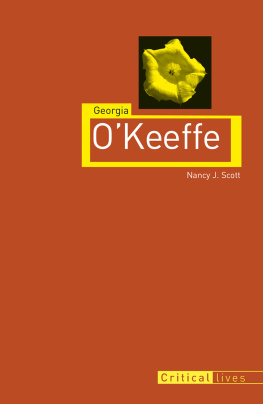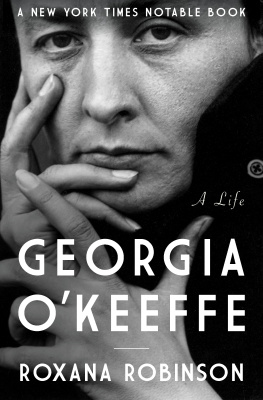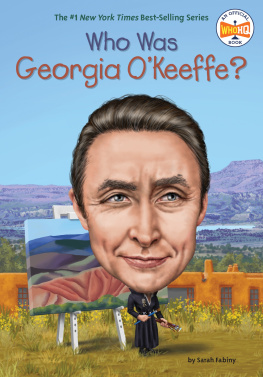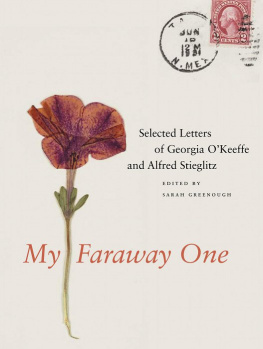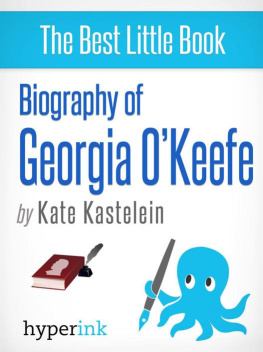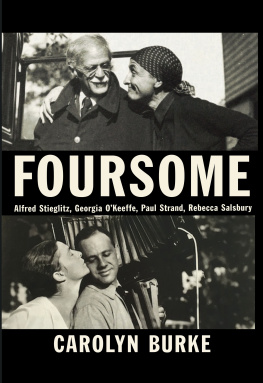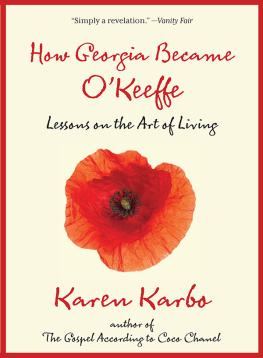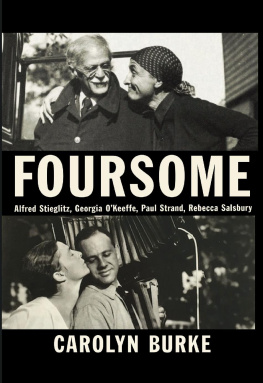Georgia OKeeffe

Titles in the series Critical Lives present the work of leading cultural figures of the modern period. Each book explores the life of the artist, writer, philosopher or architect in question and relates it to their major works.
In the same series
Georges Bataille Stuart Kendall
Charles Baudelaire Rosemary Lloyd
Simone de Beauvoir Ursula Tidd
Samuel Beckett Andrew Gibson
Walter Benjamin Esther Leslie
John Berger Andy Merrifield
Jorge Luis Borges Jason Wilson
Constantin Brancusi Sanda Miller
Bertolt Brecht Philip Glahn
Charles Bukowski David Stephen Calonne
William S. Burroughs Phil Baker
John Cage Rob Haskins
Fidel Castro Nick Caistor
Coco Chanel Linda Simon
Noam Chomsky Wolfgang B. Sperlich
Jean Cocteau James S. Williams
Salvador Dal Mary Ann Caws
Guy Debord Andy Merrifield
Claude Debussy David J. Code
Fyodor Dostoevsky Robert Bird
Marcel Duchamp Caroline Cros
Sergei Eisenstein Mike OMahony
Michel Foucault David Macey
Mahatma Gandhi Douglas Allen
Jean Genet Stephen Barber
Allen Ginsberg Steve Finbow
Derek Jarman Michael Charlesworth
Alfred Jarry Jill Fell
James Joyce Andrew Gibson
Carl Jung Paul Bishop
Franz Kafka Sander L. Gilman
Frida Kahlo Gannit Ankori
Yves Klein Nuit Banai
Akira Kurosawa Peter Wild
Lenin Lars T. Lih
Stphane Mallarm Roger Pearson
Gabriel Garca Mrquez Stephen M. Hart
Karl Marx Paul Thomas
Henry Miller David Stephen Calonne
Yukio Mishima Damian Flanagan
Eadweard Muybridge Marta Braun
Vladimir Nabokov Barbara Wyllie
Pablo Neruda Dominic Moran
Georgia OKeeffe Nancy J. Scott
Octavio Paz Nick Caistor
Pablo Picasso Mary Ann Caws
Edgar Allan Poe Kevin J. Hayes
Ezra Pound Alec Marsh
Marcel Proust Adam Watt
John Ruskin Andrew Ballantyne
Jean-Paul Sartre Andrew Leak
Erik Satie Mary E. Davis
Arthur Schopenhauer Peter B. Lewis
Susan Sontag Jerome Boyd Maunsell
Gertrude Stein Lucy Daniel
Leon Trotsky Paul Le Blanc
Richard Wagner Raymond Furness
Simone Weil Palle Yourgrau
Ludwig Wittgenstein Edward Kanterian
Frank Lloyd Wright Robert McCarter
Georgia OKeeffe
Nancy J. Scott
REAKTION BOOKS
To the memory of my mother, Lelia, and the pioneer grandmothers I never knew, women who devoted themselves to education and the cultivation of heart and mind
Published by Reaktion Books Ltd
33 Great Sutton Street
London EC1V 0DX, UK
www.reaktionbooks.co.uk
First published 2015
Copyright Nancy J. Scott 2015
All rights reserved
No part of this publication may be reproduced, stored in a retrieval system, or transmitted, in any form or by any means, electronic, mechanical, photocopying, recording or otherwise, without the prior permission of the publishers
Page references in the Photo Acknowledgements
match the printed edition of this book.
Printed and bound in Great Britain by Bell & Bain, Glasgow
A catalogue record for this book is available from the British Library
eISBN: 9781780234663
Contents

Alfred Stieglitz, Georgia OKeeffe, 1918, platinum/palladium print.
Introduction: Pioneer, Independent Spirit, Visionary
Art became Georgia OKeeffes lodestar from her earliest childhood, as she navigated towards her goal, both in and out of art schools. American pragmatism and love of the tangible, the cleanly sculpted line and the technical mastery of colour informed her art making. She first trained to be an art teacher, and in later years though she never taught again after 1918 demonstrated her didactic manner in terse but distilled ways of seeing. She articulated her artistic priority clearly: I think Id rather let the painting work for itself than help it with the word.
The artist taught her public to take time to see, admonishing those busy New Yorkers who never stopped to look at a flower. Engrossed by the worlds within flora, OKeeffe unfurled purple petunias and calla lilies, and magnified the simple stalk of corn, taking her gaze down to the fine little lake of dew nestling at the core of the plant. She wrote spare, poetic statements on nature, her meditation and the forms in my head that she always identified as the source of her daring abstractions. In one evocative passage in a letter of 1917 from OKeeffe to Alfred Stieglitz she wrote of the space that is watching the starlight that space that is between what they call heaven and earth out there in what they call the night. This liminal space, a seeming nothingness, became the centre of her creative invention.
Georgia Totto OKeeffes story is one that not only is rooted in the American prairie, where she was born on a Wisconsin dairyfarm on 15 November 1887, but also reflects the pioneer daring of the mid-nineteenth-century Dutch, Hungarian and Irish immigrant generations that formed her ancestry. She followed a peripatetic pathway to later success in New York, first studying and teaching art in both public schools and colleges. Her exhibition life as an artist began in a hastily arranged, experimental group show in May 1916, when the renowned photographer and gallery impresario Alfred Stieglitz (18641946) first showed her recent charcoal abstractions at 291 Fifth Avenue. OKeeffes art emerged precisely at the time that American women gained the right to vote, signalling her own struggle to make her voice heard through artistic expression.
The reality of the harsh winters in Wisconsin gave her grandmothers and mothers generation of pioneer women the strict resilience of making-do, learning basic life skills and surviving unforeseen crises, whether due to climate or in times of illness and death in the family. Her upbringing and childhood on a farm cultivated an independence that was both powerful and inborn. OKeeffes gaze favoured wide-open spaces her love of the wind-blown prairie in Texas and, later, the high desert vistas of New Mexico. Like the nineteenth-century pioneers moving west, OKeeffe sought out an extraordinary landscape, what many thought a desolate land. She stamped her vision of the land with the imprint of strength and endurance: the desert even tho it is vast and empty and untouchable knows no kindness with all its beauty.
OKeeffes art articulated both a modernist expressive vision, filling space in a beautiful way based on her study of Asian composition with Arthur Wesley Dow at Columbia University. Her paintings and abstract designs avoided the human figure, and she certainly never wanted to become a portraitist (though drawings of family members exist from her early training). Instead, she described her process in her own way: There are
Her innovative and sensuous embrace of nature imparted a powerful organic expression to the simple still-life, once associated with womens art. As she established her presence in New York with yearly exhibitions, beginning in 1923, her studies of flowers, shells and stones became sites of powerful meditation, and controversy. She then expanded her view of the landscape to enlarge the crosses and relics of the southwest, starting in the summer of 1929, ultimately defining a new iconography of skull, pelvis and floating antlers, ethereally and mysteriously elevated above the land, against the vast sky.

